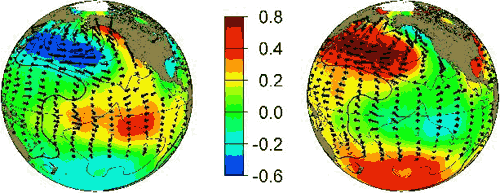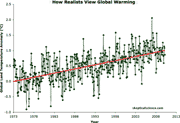The Pacific Decadal Oscillation and global warming
Posted on 15 September 2010 by Nicholas Berini
The skeptic argument “it’s Pacific Decadal Oscillation (PDO)” suggests that maybe the true cause of recent warming is the PDO. The PDO is a climate phenomenon that occurs primarily in the North Pacific Ocean. The “oscillation” happens between warm phases (positive values) and cool phases (negative values) that last anywhere from 10 to 40 years. The phases are associated with changes in sea surface temperatures (SST). While the causes of the PDO are still unknown, the primary effects seem to be changes in northeast Pacific marine ecosystems and a changing jet stream path.
Important to note, however, is that the phases are not set in stone; there are frequently short sets of 1-5 warm years during a cool phase and vice-versa. Secondly, the “warm” and “cool” phases are less descriptive than they would appear. The cool period, for instance, is actually associated with extremely high sea surface temperatures in the Northern Pacific (see image below).

Figure 1: PDO warm phase (left) and cool phase (right). Image courtesy of JISAO.
One way to test this skeptic theory is to plot the Global Temperature Anomaly alongside the PDO Index (shown below). What we find is that although the PDO index appears to influence short-term temperature changes, global temperatures have a distinct upward trend, while the PDO Index does not.

Figure 2: Pacific Decadal Oscillation index (blue, University of Washington) versus Global Temperature Anomaly (Red - GISS Temp). Smoothed data (thicker blue and red lines) and trend lines (thick straight line) are added.
Natural oscillations like PDO simply move heat around from oceans to air and vice-versa. They don't have the ability to either create or retain heat, therefore they're not capable of causing a long-term warming trend, just short-term temperature variations. Basically they're an example of internal variability, not an external radiative forcing. If PDO were responsible for warming the surface, the oceans would be cooling, which is not the case.
These results are expected. The long term warming trend is a result of an energy imbalance caused primarily by an increase of greenhouse gases in the atmosphere. In contrast, the PDO is an internal process and does not increase or decrease the total energy in the climate system.
This post is the Basic version (written by Nicholas Berini) of the skeptic argument "It's Pacific Decadal Oscillation".































 Arguments
Arguments























 0
0  0
0 Presumably, the observed temperature trend is the result of the interactions of all forcings, including those shown here and others as well. But this graph makes it clear that neither ocean oscillations nor solar irradiance is the dominant cause of the observed temperature trend since the 1970s. CO2 provides a much better fit. Adding in the effects of other greenhouse gases, and subtracting the effects of volcanic and anthropogenic aerosols, would make this match even closer.
--------------
The fine print:
PDO data from University of Washington. Surface temperatures from GISS land+ocean. Satellite temperatures from RSS. Law Dome CO2 from NOAA NCDC. Mauna Loa CO2 from NOAA ESRL. PDO and temperature data shown in monthly and 120-month LOESS smoothed versions. Law Dome CO2 dating based on "air age" with 20-year smoothing. Mauna Loa CO2 (monthly) are seasonally adjusted. Both CO2 data sets were log-transformed (base 2). Data sets with differing units (PDO, temperature, log[CO2]) have been scaled to fit on the same graph. Solar irradiance data from University of Colorado, shown annually and with a 22-year LOESS smoothing function.
Presumably, the observed temperature trend is the result of the interactions of all forcings, including those shown here and others as well. But this graph makes it clear that neither ocean oscillations nor solar irradiance is the dominant cause of the observed temperature trend since the 1970s. CO2 provides a much better fit. Adding in the effects of other greenhouse gases, and subtracting the effects of volcanic and anthropogenic aerosols, would make this match even closer.
--------------
The fine print:
PDO data from University of Washington. Surface temperatures from GISS land+ocean. Satellite temperatures from RSS. Law Dome CO2 from NOAA NCDC. Mauna Loa CO2 from NOAA ESRL. PDO and temperature data shown in monthly and 120-month LOESS smoothed versions. Law Dome CO2 dating based on "air age" with 20-year smoothing. Mauna Loa CO2 (monthly) are seasonally adjusted. Both CO2 data sets were log-transformed (base 2). Data sets with differing units (PDO, temperature, log[CO2]) have been scaled to fit on the same graph. Solar irradiance data from University of Colorado, shown annually and with a 22-year LOESS smoothing function.







Comments